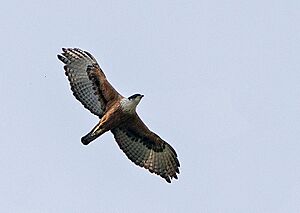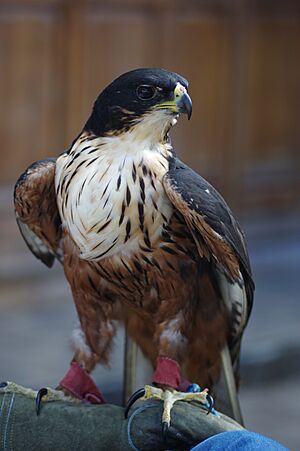Rufous-bellied eagle facts for kids
Quick facts for kids Rufous-bellied eagle |
|
|---|---|
 |
|
| Conservation status | |
| Scientific classification | |
| Genus: |
Lophotriorchis
|
| Species: |
kienerii
|
| Subspecies | |
|
|
| Synonyms | |
|
|
The rufous-bellied eagle (Lophotriorchis kienerii) is a cool bird of prey that lives in the forests of tropical Asia. Even though it's called an eagle, it's quite small for an eagle. It has striking patterns, a bit like a falcon. Scientists used to place it in other groups, but now they think it's special enough to have its own group.
Contents
Meet the Rufous-Bellied Eagle: What It Looks Like
Adult rufous-bellied eagles are easy to spot because of their unique look. They have a black head, almost like a hood, with a small crest. Their belly and the underside of their wings are a rich chestnut color. This contrasts sharply with their white throat and chest.
Size and Differences Male and female eagles look very similar. However, females are usually a bit bigger. They also have a little more black on their face. When they perch, they stand very straight. Their wingtips almost reach their tail. Young eagles look different. They have very white undersides. They also have dark marks on their sides and head.
Where Do Rufous-Bellied Eagles Live?
You can find the rufous-bellied eagle in southern and southeastern Asia. Their home range stretches all the way to a large island called Sulawesi.
Their Forest Homes These eagles love living in hill forests. In India, they are more common in the Western Ghats. You can also find them along the Himalayas, from Nepal to Assam. They also live in parts of the Eastern Ghats.
Life and Habits of the Rufous-Bellied Eagle
Rufous-bellied eagles are often seen flying high above the forest. They soar gracefully, looking for their next meal.
Hunting and Diet These eagles are skilled hunters. They dive down to catch prey. Their meals can include other birds and small mammals. They hunt in the air, in the trees, or on the forest floor. Some birds they eat are the Sri Lanka wood pigeon and Kalij pheasant. They also eat junglefowl.
Reproduction and Family Life The breeding season for these eagles is in winter. Their young birds are ready to fly in spring. This is a good time because many prey animals are also having babies. When they want to find a mate, they perform special flights. These flights include diving and shaking their wings.
Nests and Calls They build large nests on tall, often bare trees. Their nests are big platforms made of dry sticks and branches. They break off these branches themselves! They line the nest with green leaves. The female eagle usually lays just one egg. Both parents take turns sitting on the egg. They also share the job of feeding their chick. They protect their nest from danger. Their calls sound like high-pitched fwick, fwick... notes. These are followed by a thin sweek! sound.
How Scientists Study and Name Them
Scientists classify living things into groups. This is called taxonomy. This eagle was first named Astur kienerii. Later, it was moved to different groups. These included Limnaetus and Hieraaetus. Scientists now think it's unique enough for its own group, Lophotriorchis.
Subspecies and Names There are two types of rufous-bellied eagles. They are called subspecies. They look very similar. One is kienerii, found in India and Sri Lanka. The eagles in the north are bigger. The other is formosus. It lives across Southeast Asia, from Burma to Sulawesi. The eagle's name honors a French naturalist named Louis Charles Kiener.




